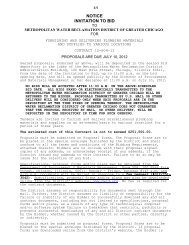Report - Metropolitan Water Reclamation District of Greater Chicago
Report - Metropolitan Water Reclamation District of Greater Chicago
Report - Metropolitan Water Reclamation District of Greater Chicago
You also want an ePaper? Increase the reach of your titles
YUMPU automatically turns print PDFs into web optimized ePapers that Google loves.
nitrogenous oxygen-demanding substances, and the volume <strong>of</strong> CSOs collected by the T ARP<br />
systems.<br />
Calculating pollution removal gives an indication <strong>of</strong> how well T ARP is serving its<br />
function, since the pollutants diverted to T ARP would have otherwise been discharged into the<br />
area waterways. The results <strong>of</strong> the calculations will be sent to M&O and also published in the<br />
2010 EM&RD annual report in 2011.<br />
Estimation <strong>of</strong> Emission <strong>of</strong> Hazardous Air Pollutants from <strong>Metropolitan</strong> <strong>Water</strong><br />
<strong>Reclamation</strong> <strong>District</strong> <strong>of</strong> <strong>Greater</strong> <strong>Chicago</strong> <strong>Water</strong> <strong>Reclamation</strong> Plants. Under Section 112 <strong>of</strong> Title<br />
I <strong>of</strong> the Clean Air Act, a publicly owned treatment works (POTW) is considered a major source<br />
<strong>of</strong> HAPs if it emits or has the potential to emit 10 tons per year or more <strong>of</strong> any HAP or 25 tons<br />
per year or more <strong>of</strong> any combination <strong>of</strong> HAPs. As part <strong>of</strong> the NPDES permits and regulations<br />
under the Clean Air Act, emission <strong>of</strong> HAPs from the wastewater treatment processes for each<br />
WRP was estimated.<br />
Estimation <strong>of</strong> the emissions <strong>of</strong> these HAPs from the wastewater treatment process units is<br />
made using the Bay Area Sewage Toxics Emissions (BASTE) computer model developed by<br />
CH2M Hill. According to the output from the BASTE model, all <strong>of</strong> the individual HAP<br />
emissions were less than the 10 ton/year criterion at any <strong>District</strong> WRP. Toluene and<br />
acetaldehyde were the predominant compounds emitted from the wastewater treatment processes<br />
at the Stickney WRP. Carbon disulfide was the predominant compound emitted from the<br />
Calumet WRP liquid stream. The total measured HAP emissions were substantially less than the<br />
25 ton/year threshold at each <strong>of</strong> the three large WRPs. The wastewater treatment process units at<br />
the <strong>District</strong>'s WRPs are not a major source <strong>of</strong> HAPs.<br />
Conducting Applied Research on Process Optimization and Evaluation <strong>of</strong> New<br />
Technologies. The WTPR Section conducted the following applied research projects in 2010.<br />
Characterization <strong>of</strong> Recycle Streams at the Stickney and Calumet <strong>Water</strong> <strong>Reclamation</strong><br />
Plants. In July 2008, the WTPR Section began sampling the recycle streams at the Stickney and<br />
Calumet WRPs in order to evaluate the nutrient loads to the headwork contributed by these<br />
recycle streams. The <strong>District</strong> does not routinely monitor flow <strong>of</strong> recycle streams or nutrient<br />
contents in the recycle streams at either plant. However, grab samples are collected from certain<br />
recycle streams for total and suspended solids analyses for process control information. The<br />
parameters analyzed in this study have been chosen such that a range <strong>of</strong> nutrient treatment<br />
strategies may be considered to address stricter nutrient regulations for TN and TP. Thus, the<br />
characterization <strong>of</strong> nutrient loads in recycle streams will provide important information for<br />
formulating the nutrient reduction strategies for both WRPs. Sampling for this project continued<br />
through August 2009. The findings <strong>of</strong> the study were presented at the November 2010 M&R<br />
seminar, which included the details <strong>of</strong> sampling plan, data, and a set <strong>of</strong> recommended<br />
technologies for nutrient treatment and recovery based on the data collected. A final report<br />
detailing this study will be completed in 2011.<br />
22
















